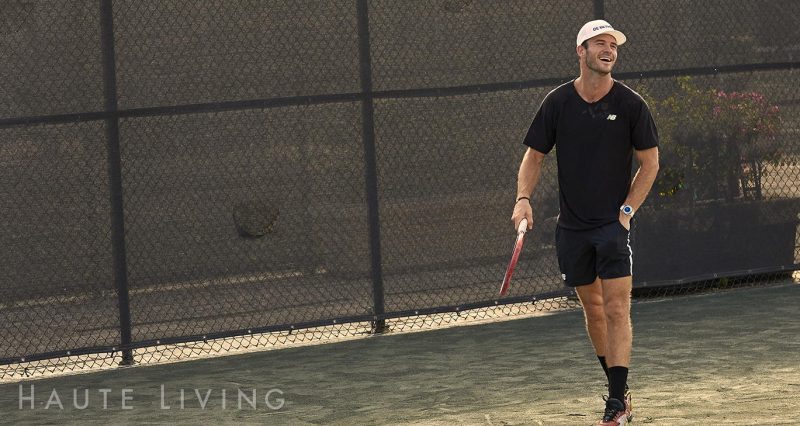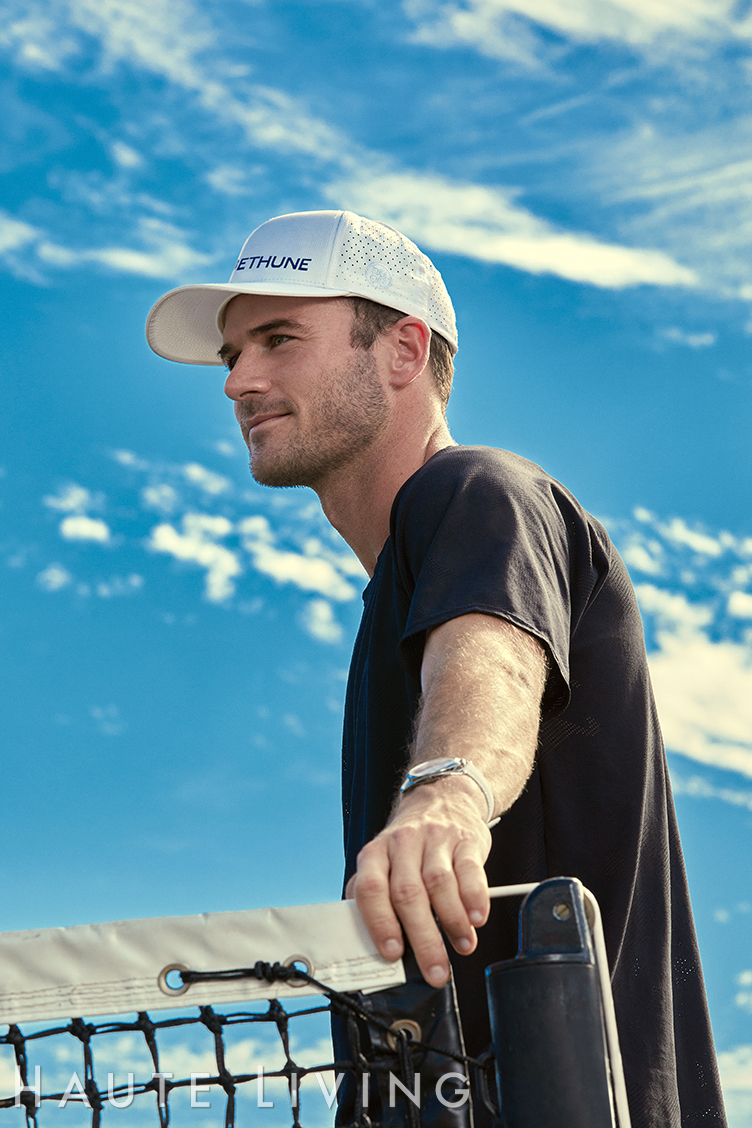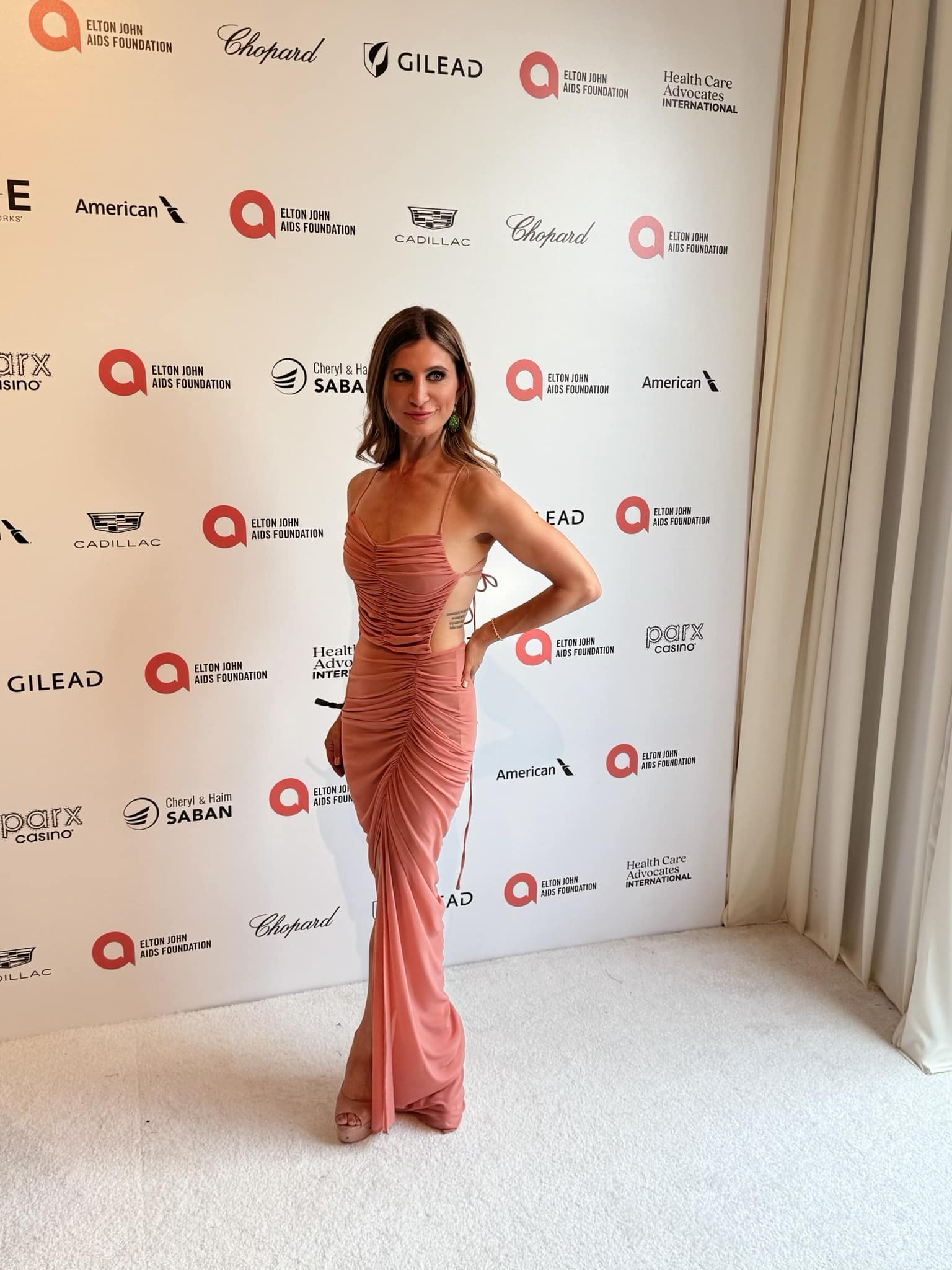Tommy Paul And The Road To Olympic Glory
 Photo Credit: ALBERTO GONZÁLEZ
Photo Credit: ALBERTO GONZÁLEZ
BY LAURA SCHREFFLER
PHOTOGRAPHY ALBERTO GONZÁLEZ
PHOTOGRAPHY ASSISTANT DANIELA MARTIN
SHOT ON LOCATION AT THE BOCA RATON IN BOCA RATON, FL.
Tommy Paul is feeling powerful. The unlikely source of his Superman-like force: his watch.
The 26-year-old American tennis pro, currently ranked 15th in the world, has just settled down to chat at his Floridian home after a grueling day of practice post-Australian Open. He looks damp, but not exhausted — and in his opinion, it’s because his De Bethune timepiece is bringing him life. Or energy, at the very least.
“This is the one I was wearing during last year’s U.S. Open and this year’s Australian Open,” he says of the DB28xs Starry Seas, a silver-plated timepiece with a mechanical hand-wound movement and the world’s first random guilloché blue titanium dial, emblazoned with a starry sky and white gold stars. “There’s great energy in this watch, which is why I love playing in it.”
Paul wasn’t always so in tune with his mystical side, but that all changed last year, when the brand sought him out after seeing him play in the Mexican Open in Acapulco. They sent him their signature DB28, a surprisingly light piece identified by the presence of “floating lugs,” a patented system that easily adjusts to the size of the wrist and its various movements. “[When I first started working with De Bethune], they told me about the energy the watches bring, but I couldn’t believe it… until I started wearing them,” he admits.
Now, he can’t go without what he refers to as “the perfect watch for playing tennis” — especially a one-off piece the brand made just for him at grass court season last year, in the Wimbledon colors of purple and green. “I’d never played a match with a watch in my life, but I got this one, and I just had to play in it. I ended up winning matches and making the finals with it. It has this energy that actually helps me on the court. It’s my go-to for life now,” he declares.
Maybe it’s superstition — common among athletes — but belief is a powerful tool. And Paul is convinced that the DB28 Starry Seas was the driving force behind his career high, besting number two seeded player Carlos Alcaraz at the National Bank Open in Toronto last August. “I had a great time there,” he recalls. “I made it to the semis, beat Alcaraz there. I lost to [Jannik Sinner] in the semifinals, but I played a great match there, too.”
Although collecting timepieces is a newer passion, it’s one he’s fully immersed himself in. He says he started to take active notice around age 20, but it wasn’t until he began working with coach Brad Stine that he became a serious collector. “Brad is a watch freak,” Paul says with a laugh. “He loves it more than anything, and he got me all the way in and out. Our group chat is just tennis and watches; that’s what we’re sending each other back and forth.”
Currently, his collection consists entirely of De Bethune pieces, save for an incredibly rare Hamilton watch engraved with USA 2020 — a watch entirely reserved for Olympic competitors. “I imagine I’ll be getting another one when we play in the Olympics this summer,” he says, and smiles. “Hopefully, the rest of my watches, other than De Bethune, are just a bunch of Olympic watches.”
Paul confidently states that he’ll be playing in the Olympic Summer Games Paris 2024 this summer, where he’ll likely be joined by Taylor Fritz, Ben Shelton, and Frances Tiafoe on the men’s side, all of whom hold spots within the ATP’s top 20 worldwide rankings. And when I say confident, I mean confident. He’s laid-back about what most would consider to be the be-all, end-all pinnacle of athleticism — and much more enthusiastic about having a true Olympic experience — which makes sense, given that he was undeniably robbed of this his first time playing in the Games during the height of the pandemic. “I played three years ago in Tokyo, and that was a strange experience because of Covid-19. We stayed in a hotel along with the USA Basketball team — not in the village — so we didn’t get any of the true Olympic experience. That’s what I’m looking forward to in Paris: getting to play without all the Covid protocols.”
 Photo Credit: ALBERTO GONZÁLEZ
Photo Credit: ALBERTO GONZÁLEZ
Still, he allows, “I’m super excited to play, and hopefully take home a medal for our country. That’s always been the dream.”
And just because Paul isn’t doing anything additional to prepare doesn’t mean he isn’t taking the Games seriously. [Also, he’ll be wearing his lucky charm — which he did not yet have at his first go at Olympic glory — so why worry?] On this front, he has an entirely logical explanation. “In a lot of other sports, you train and peak at the Olympics, and train harder to get there. Our season is constant throughout the year, so there isn’t a dedicated ramp up; you always have to be consistent in your game. It’s an interesting sport in that respect. I’m not treating it differently than any other tournaments. I want to do as well as I can, but every tournament I play, I want to win just as badly.”
His career high came at the ATP Masters 1000 Shanghai, where he became the ATP’s world No. 12. Breaking the top ten is a major focus for 2024, mostly in that he consistently strives to beat his personal best. “Winning is the most important thing to me right now,” he confesses, admitting, “I enjoy competing, and I hate losing. But tennis is unlike any other sport in that you lose almost every week of the year. You play a tournament every week, and if you make the finals, it’s a good week. But even if you lost that week, you still show up to the next tournament, and 99 percent of the players in that tournament have also lost the week before; everyone loses outside of one person. I have a lot of friends in the sport, and when they’re in a slump, I tell them, ‘You haven’t been playing well, and you’re stressed about not playing well. But the guy you’re playing tomorrow, he lost his last match, too, so he could also lose to you tomorrow.’ We do the best we can with every match we play.”
In that respect, Paul, a player whose style is defined by a strong, attacking forehand, solid footwork along the baseline, and speed coming into net, doesn’t sweat his competition. Though he loves the friendly, on-court rivalry he has with Alcaraz, again, his biggest competition is himself. “Tennis is an independent, solo sport — your greatest enemy is always going to be yourself. But that’s also what pushes you to the next level. There’s so much self-doubt when you’re playing an individual sport. You don’t have a team to blame — it’s all on you. You have your support team, but you’re the only one out there playing. That, in my opinion, is the beauty of the sport — and I think it’s the most beautiful sport in the world for that reason.”
 Photo Credit: ALBERTO GONZÁLEZ
Photo Credit: ALBERTO GONZÁLEZ
THE YOUNG MAN sitting before me today might look virtually the same as his younger self, but Tommy Paul is a different person. Tennis is his life, and his life, tennis.
When I ask him who Tommy Paul really is, his answer is revealing: “I’m a competitor and a tennis player. At heart, I feel like that’s who I am,” he says.
“That,” I say, “is what you do. But who are you?”
“That is who I am,” he insists. “I honestly love the sport. It’s engraved in me. Obviously, tennis is exhausting; it’s a long season. But I enjoy it even in the tough times. I love competing; that’s what I was trained for, it’s why I play. I do like to have fun, I like to hang out with my friends. I’m a normal person, but I’m also a competitor.”
The New Jersey-born, North Carolina-raised, and now-Boca Raton, Florida resident hasn’t always been entirely focused on winning. When he turned pro in 2015, he was just a guy that wanted to have fun. This was brought to light on the early Janaury episode “Friend or Foe” of the second season of Netflix’s hit tennis docuseries, Break Point, a behind-the-scenes look at the lives of top tennis players (including Fritz, Alcaraz, Coco Gauff, Daniil Medvedev, Jessica Pegula, and Alexander Zverev, among others) as they travel across the globe for all four Grand Slams as well as the ATP and WTA tours.
“When I turned pro, I was more in my party phase,” he says in the series. “I had a little money and I thought, ‘Let’s have fun.’ I kind of got caught up in it.” It came to a head at the 2017 US Open, of which he says in the episode, “I had a night out drinking and the next day, I was supposed to play doubles. I was not there. I couldn’t even see. I was getting alcohol tested for six months. That’s when I thought, ‘This has got to be rock bottom.’ I knew I had to turn something around. That’s when I started taking everything more seriously.”
Paul has become a man of his word. Since he truly buckled down, his career has been on a slow and steady rise. He cracked the top 200 for the first time in 2016, the top 100 in 2019, and the top 50 in 2021 — the same year as his Olympics debut. He ended the year with a world rank of 43.
And perhaps it was his lucky timepiece charm, or his own seriousness about the sport (or a combination of the two) but his prowess on the court — clay preferred, previously — was visible. In 2022, at the Indian Wells Masters, he reached the third round for a second time, losing to 29th seed Alex de Minaur. One week later at the Miami Open, he reached the third round for the first time. Then, seeded 30th at Wimbledon that same year, he reached the fourth round of a Grand Slam for the first time in his career. He recorded the biggest win of his career, defeating world No. 2 Rafael Nadal in the second round at the 2022 Rolex Paris Masters, his fourth top 10 victory of the year.
 Photo Credit: ALBERTO GONZÁLEZ
Photo Credit: ALBERTO GONZÁLEZ
2023 was more of the same impressive upward trajectory. Paul reached his first Grand Slam semifinal at the 2023 Australian Open, becoming the first American male player to reach the semifinals at this Major since Andy Roddick in 2009. He lost to eventual champion Novak Djokovic, which was enough to place him within the top 20 at world No. 19. He then reached his second and biggest career final at the ATP 500 2023 Mexican Open, and then reached the fourth round for the first time at the Masters 1000, which brings us to now, and his press-time ranking of world no. 15.
Even playing at home in Florida feels different. Although this is where he’s surrounded by family and friends, it was also, traditionally, a go-to place of fun… and he is not about to go back to that time of his life. Now, the Miami Open is like any other tournament in the sense that it’s another opportunity to win — it just happens to be on familiar ground. “The fun has changed over the years,” he confides. “At one point, I was going to Miami quite a bit, and then I grew out of that and wanted to be slower paced. Now, I try to spend as much time [chilling out] as I can, whether it’s at the beach, fishing, by the ocean, or at dinner. My girlfriend [influencer Paige Lorenze] makes me home-cooked meals. Tomorrow, we’ll have a bunch of the Americans over for dinner.” He shrugs. “One of the hardest parts about tennis is how much time you’re away from your family and friends, so when I’m here, I like to keep it simple.”
Paul’s script has officially flipped. Even his way of prepping is different. “Before matches, I like to sit by myself. I turn off my phone. I think it’s powerful to be by yourself and alone with your thoughts before you go and play.”
And there you have it. Paul is focused, he is determined, and he has goals. “I want to win tournaments,” he declares. “I want to go home as a champion. I know that’s probably a corny goal, but there it is. I want to end tournaments on a win. Last year, every week that I played, I lost my last match. I got number 12 in the world, so I did pretty well, but I didn’t break the top 10 — and that’s another goal. But I guess if I win tournaments, that’ll help me get to the top 10, so my goals go hand in hand.”
He wants more big wins, certainly, including standouts like his maiden ATP title at the 2021 Stockholm Open, and that huge upset at the 2023 National Bank Open against Alcaraz. “All my matches felt super electric after that,” he reminisces.
But given that he’s referenced this particular on-court match-up several times throughout our chat, enquiring minds want to know how he celebrated one of the most pivotal moments of his career. Paul remembers it perfectly and says that it serves as an exact reminder of what he’s been preaching all along: win or lose, tomorrow is another day.
After beating Alcaraz in Toronto, he went to dinner with his team, inclusive of coach Stine, fitness coach Franco Herrero, and physiotherapist Sebastian Cozzarin, knowing that he must defeat Jannik Sinner (who has just won the Australian Open) the following day. He could not just let his hair down and enjoy himself — he had a battle ahead. “We finished late that day, but the tournament kept a restaurant open so we could get a late-night meal. And it was funny — Alcaraz also showed up at the restaurant 20 minutes later. He was waving at us, and smiling as he went upstairs. I remember thinking he probably had much more fun than I did, because I had to play the next day. But also, there was no animosity from him either way: guys at the top of their game are that way.”
Willfully forgetting losses requires Groundhog Day syndrome to be sure, and Paul has it — but he believes it’s just the way life must be; it’s the only way to move forward. And that’s what he’s doing now, leaving the Australian Open behind and focusing on the tournaments to come — Delray Beach, Dallas, Miami, and Indian Wells (which he calls the “most special tournament outside of Wimbledon”) included.
“Playing those tournaments as an American is super important,” he says, explaining, “American tennis players haven’t always had the fan base they do now. And for us [inclusive of players like Fritz, Pegula, Gauff, and Shelton], we love playing in front of the US fans; that’s what we live for. It’s all about inspiring kids to play more tennis and having them love the sport like we do. It’s cool to see people getting into tennis in the States again. I think that’s been missing — we haven’t had players [this great] for a while, and now I feel like we have a good group that is moving step by step, spot by spot, to the top of the game.”
As we sign off, I wonder if I should wish him luck — or if it’s bad luck to do so. Paul smiles, and says, “We take all the luck we can get over here.”
He might take it, but does he need it? Likely not… he has all that BWE (otherwise known as “Big Watch Energy”), after all.
 Photo Credit: ALBERTO GONZÁLEZ
Photo Credit: ALBERTO GONZÁLEZ













